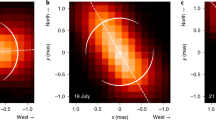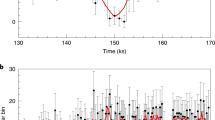Abstract
The properties of the recently discovered1,2 extrasolar planets were not anticipated by theoretical work on the formation of planetary systems, most models for which were developed to explain our Solar System. Indeed, the observational technique used to detect these planets (measurement of radial-velocity shifts in stellar spectral lines) do not yet have the sensitivity to detect planetary systems like our own3. Here we report observations and modelling of the gravitational microlensing event MACHO-97-BLG-41. We infer that the lens system consists of a planet of about 3 Jupiter masses orbiting a binary stellar system consisting of a late-K dwarf star and an M dwarf. The stars are separated by ∼1.8 astronomical units (1 AU is the Earth–Sun distance), and the planet is orbiting them at a distance of about 7 AU. We had expected to find first the microlensing signature of jovian planets around single stars, so this result suggests that such planets orbiting short-period binary stars may be common.
This is a preview of subscription content, access via your institution
Access options
Subscribe to this journal
Receive 51 print issues and online access
$199.00 per year
only $3.90 per issue
Buy this article
- Purchase on Springer Link
- Instant access to full article PDF
Prices may be subject to local taxes which are calculated during checkout



Similar content being viewed by others
References
Mayor,M. & Queloz,D. A Jupiter-mass companion to a solar-type star. Nature 378, 355–357 (1995).
Marcy,G. W. & Butler,R. P. Detection of extrasolar giant planets. Annu. Rev. Astron. Astrophys. 36, 57–98 (1998).
Cumming,A., Marcy,G. W. & Butler,R. P. The Lick planet search: detectability and mass thresholds. Astrophys. J. (in the press); preprint astro-ph/9906466 at 〈http://xxx.lanl.gov〉 (1999).
Mao,S. & Paczyński,B. Gravitational microlensing by double stars and planetary systems. Astrophys. J. 374, L37–L41 (1991).
Aubourg,E. et al. Evidence for gravitational microlensing by dark objects in the galactic halo. Nature 365, 623–625 (1993).
Alcock,C. et al. Possible gravitational microlensing of a star in the Large Magellanic Cloud. Nature 365, 621–623 (1993).
Udalski,A. et al. The optical gravitational lensing experiment. Discovery of the first candidate microlensing event in the direction of the galactic bulge. Acta Astron. 43, 289–293 (1993).
Alcock,C. et al. Binary microlensing events from the MACHO project. Astrophys. J. (submitted); preprint astro-ph/9907369 at 〈http://xxx.lanl.gov〉 (1999).
Albrow,M. et al. Limb-darkening of a K giant in the galactic bulge: PLANET photometry of MACHO 97-BLG-28. Astrophys. J. (in the press); preprint astro-ph/9811479 at 〈http://xxx.lanl.gov〉 (1999).
Udalski,A. et al. The optical gravitational lensing experiment: OGLE no. 7: binary microlens or a new unusual variable? Astrophys. J. 436, L103–L106 (1994).
Alard,C., Mao,S. & Guibert,J. Object DUO 2: a new binary lens candidate? Astron. Astrophys. 300, L17–L20 (1995).
Dominik,M. Galactic microlensing with rotating binaries. Astron. Astrophys. 329, 361–374 (1998).
Diaz-Cordoves,J., Claret,A. & Gimenez,A. Linear and non-linear limb-darkening coefficients for LTE model atmospheres. Astron. Astrophys. Suppl. Ser. 110, 329–350 (1995).
Lennon,D. J. et al. Real-time spectroscopy of gravitational microlensing events—probing the evolution of the galactic bulge. ESO Messenger 90, 30–38 (1997); preprint astro-ph/9711147 at 〈http://xxx.lanl.gov〉 (1999).
Holman,M. J. & Wiegert,P. A. Long-term stability of planets in binary systems. Astron. J. 117, 621–628 (1999).
Alcock,C. et al. Calibration of the MACHO photometry database. Proc. Astron. Soc. Pac. (in the press).
Bertelli,G., Bressan,A., Chiosi,C. Fagotto,F. & Nasi,E. Theoretical isochrones from models with new radiative opacities. Astron. Astrophys. Suppl. Ser. 106, 275–302 (1994).
Gaudi,B. S. Distinguishing between binary-source and planetary microlensing perturbations. Astrophys. J. 506, 533–539 (1998).
Glanz,J. Flickers from far-off planets. Science 277, 765 (1997).
Rhie,S. H. et al. On planetary companions to the MACHO-98-BLG-35 microlens star. Astrophys. J. (in the press); preprint astro-ph/9905151 at 〈http://xxx.lanl.gov〉 (1999).
Jensen,E. L. N. & Mathieu,R. D. Evidence for cleared regions in the disks around pre-main-sequence spectroscopic binaries. Astron. J. 114, 301–316 (1997).
Bennett,D. P. et al. The MACHO Project II: data reduction and analysis of 6 million lightcurves. BAAS 183, 7206 (1993).
Stetson,P. The center of the core-cusp globular cluster M15: CFHT and HST observations, ALL-FRAME reductions. Proc. Astron. Soc. Pacif. 106, 250–280 (1994).
Han,C. & Gould,A. The mass spectrum of MACHOs from parallax measurements. Astrophys. J. 447, 53–61 (1995).
Acknowledgements
The authors are members of the MPS Collaboration and the Wise Observatory GMAN Team. We thank the MACHO, OGLE and EROS collaborations for announcements of microlensing events in progress, and the MACHO team for their discovery of MACHO-97-BLG-41. We also thank W. Sutherland for access to his likelihood estimation code. This work was supported in part by the NASA Origins program, the US NSF and a Research Innovation Award for the Research Corporation. Work performed at MSSSO is supported by the Australian Department of Industry, Technology and Regional Development. Work performed at UW is supported in part by the Office of Science and Technology Centers of NSF. Astronomy at Wise Observatory is supported by the Israel Science Foundation.
Author information
Authors and Affiliations
Corresponding author
Rights and permissions
About this article
Cite this article
Bennett, D., Rhie, S., Becker, A. et al. Discovery of a planet orbiting a binary star system from gravitational microlensing. Nature 402, 57–59 (1999). https://doi.org/10.1038/46990
Received:
Accepted:
Issue Date:
DOI: https://doi.org/10.1038/46990
This article is cited by
-
Studying planet populations by gravitational microlensing
General Relativity and Gravitation (2010)
Comments
By submitting a comment you agree to abide by our Terms and Community Guidelines. If you find something abusive or that does not comply with our terms or guidelines please flag it as inappropriate.



